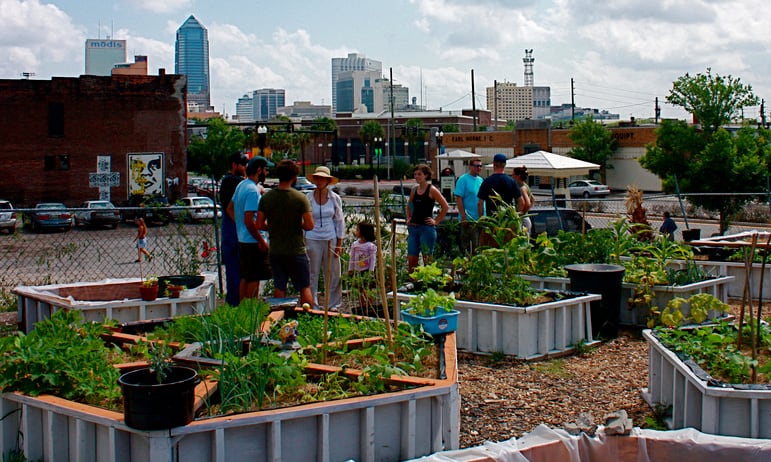City Blooming for Dummies
Table of ContentsThe Main Principles Of City Blooming Some Known Factual Statements About City Blooming The Buzz on City BloomingWhat Does City Blooming Do?The Greatest Guide To City Blooming
Intrigued in expanding food to buy in the City of Chicago? Thinking of beginning an area garden? Modifications to the Chicago Zoning Regulation enable agricultural uses like neighborhood gardens and urban farms in numerous components of the city. Below is a listing of regularly asked concerns pertaining to the rules and guidelines that farmers need to consider when intending a city agriculture task.
The zoning change does not change any various other codes managing composting, building authorizations, buying or renting City possessed residential or commercial property, service licenses or ecological contamination. There are existing codes that regulate these concerns and they stay in full impact and may be appropriate to your job. Community yards are usually owned or managed by public entities, public organizations or community-based companies and preserved by volunteers.
Urban farms grow food that is intended to be offered, either on a not-for-profit or for-profit basis. Because of their business function, urban ranches require a business license. Yes. An area yard is permitted to market surplus create that was expanded on website if the sales are accessory or subordinate to the yard's primary purpose defined over.
City Blooming - An Overview
The quantity of garden compost material can not surpass 25 cubic backyards at any given time according to the requirements in 7-28-715 of the City's Municipal Code. Since the soil at a lot of brand-new yard sites needs modifying, compost, dirt, wood chips, or various other materials can be obtained to construct or enhance the growing room.

If a structure authorization is required after that the hoophouse will certainly be thought about an accessory building. You can learn more regarding the structure authorization needs by speaking to the Department of Buildings. The 25,000-square-foot dimension restriction is meant to stop a solitary neighborhood garden from controling a given block or interfering with the block's existing residential or industrial personality.
The limit does not use to yards found in Public Open Space (POS) districts. Can there be even more than one neighborhood yard that is 25,000 square feet on a single block? Fence is not required, however, yards that have large car parking locations may be needed to mount fence or other landscape design functions.
5 Simple Techniques For City Blooming
B1 & B2 districts call for that all business use tasks be conducted inside. R areas restrict business activity. The policies mirror the function and intent of the Zoning Code. Is fencing needed for urban ranches? Yes. Fences may be called for, together with landscaping and testing, for certain auto parking areas and exterior job or storage space areas relying on place and the specific activity happening.
Yes. Urban ranches need structure authorizations and zoning approvals prior to building and construction. Other types of city evaluation may be called for depending upon specific frameworks, activities, size, landscaping, licensing, public heath and stormwater monitoring concerns. A number of these needs are recognized in the job design or permitting procedure, however, the candidate might be accountable to separately determine details licenses or permits that might be required.
The Department of Company Affairs and Consumer Security can assist figure out the details type of organization license that's called for. Off street parking is required for a lot of business projects in Chicago. The required number of car park areas is based on the number of employees functioning on website and not the square video footage of the growing area.
The Ultimate Guide To City Blooming

Yes. A metropolitan ranch can sell compost product produced on website, nevertheless, the operation has to follow the policies in 7-28-715 of the Chicago Municipal Code. Yes. Aquaponic systems are allowed inside your home on metropolitan farms in numerous zoning areas. Nevertheless, a zoning evaluation and building license is required in order to mount frameworks or systems and a business certificate is needed as described over.
As much as 5 hives or nests of honey bees might be kept as an accessory usage. Nevertheless, beekeepers must sign up with the Illinois Department of Farming. For additional information regarding the suggested zoning amendment you might contact the Division of Housing and Economic Development, Bureau of Planning and Zoning at 312.744.8563.
Farming in cities and urban locations An urban ranch in Chicago. Urban farming describes different practices of cultivating. https://canvas.instructure.com/eportfolios/2986028/Home/City_Gardening_A_Green_Oasis_in_the_Concrete_Jungle, processing, and distributing food in metropolitan areas. The term additionally applies to the location tasks of pet husbandry, tank farming, beekeeping, and gardening in an urban context. Urban agriculture is identified from peri-urban farming, which occurs in backwoods at the edge of suburbs.
4 Simple Techniques For City Blooming
It can involve a movement of organic farmers, "foodies" and "locavores", who look for to form socials useful reference media based on a common ethos of nature and community holism. These networks can establish by method of formal institutional support, becoming incorporated right into regional community planning as a "transition town" movement for lasting city development.
In either case, the a lot more straight accessibility to fresh vegetable, fruit, and meat items that might be realised with city agriculture can boost food protection and food security while reducing food miles, resulting in reduced greenhouse gas exhausts, thus adding to climate change mitigation. Several of the very first evidence of urban farming originates from Mesopotamia.